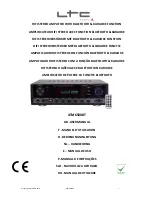
Captain-i, Installation Guide
28
Code Report
AC/RESTR AC
failure/Restore
LB/RESTR Low
battery
failure/Restore
PF/RESTR
Low card voltage (less than 9V)/ Restore
PH/RESTR
Telephone failure/ Restore
TST
Test code (automatic, manual, remote)
PNC
Panic code (pressing both
and
keys)
FUS/RESTR Detector power failure/ Restore
ONG/OFG
System armed with a non-user code (short code, for example)/ System
disarmed with a non-user code
ON1/OFF1 -
ON8/OFF8
System armed/disarmed with User #1 to user #8 code
BPS/RST
System armed with bypassed zones/ code for stopping of siren operation
Table 4.
Default report codes
Note: The PF reporting code (low voltage) indicates that the battery is about to be
empty. This should be defined at the Monitoring Station as an emergency event
requiring immediate attention.
5.3.3
Setting monitoring station telephone numbers
[
, the display will show “Station Phone”.
[
, the display will show
"Telephone 1", enter the telephone number and press
. The display will
show "Telephone 2", enter the telephone number and press
, the display will
show "Telephone 3", enter the telephone number and press
, the display will
show "Telephone 4", enter the telephone number and press
CAPTAIN-i is capable of calling the Monitoring Station and reporting various types of
events. It is possible to program four different numbers (up to 16 digits per number).
The system begins to call the first number. If the connection is unsuccessful, the
system will try (8 trials) to dial the other numbers, until a successful connection is
made or until eight trials have been made. If a successful connection is not
established, a Communication Fault is recorded in the memory and FAULT Led will
blink.
Note: If dialing is done through a switchboard and there is a digit to get an outside line
(usually 9), a 1-second delay between the dialing of that digit and the rest of the
number may be programmed by entering
. For example, if the number to be
dialed via a switchboard is 3.586.9313, the number should be programmed as follows:
9*35869313
















































